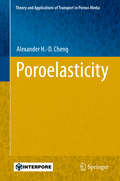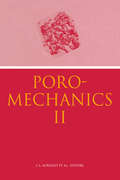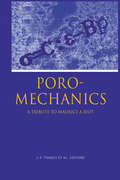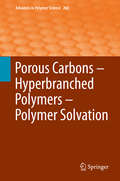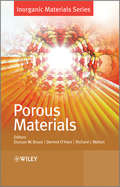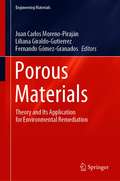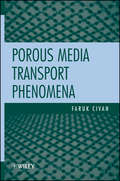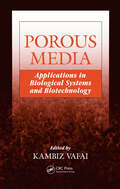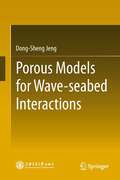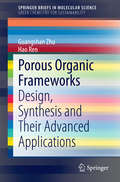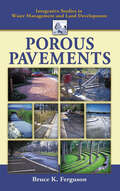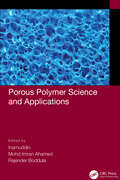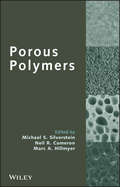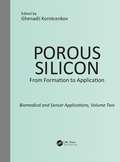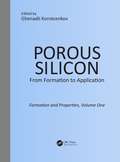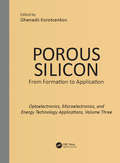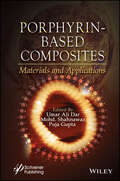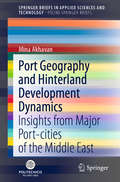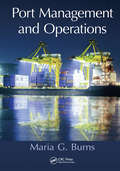- Table View
- List View
Poroelasticity
by Alexander H.-D. ChengThis book treats the mechanics of porous materials infiltrated with a fluid (poromechanics), focussing on its linear theory (poroelasticity). Porous materials from inanimate bodies such as sand, soil and rock, living bodies such as plant tissue, animal flesh, or man-made materials can look very different due to their different origins, but as readers will see, the underlying physical principles governing their mechanical behaviors can be the same, making this work relevant not only to engineers but also to scientists across other scientific disciplines. Readers will find discussions of physical phenomena including soil consolidation, land subsidence, slope stability, borehole failure, hydraulic fracturing, water wave and seabed interaction, earthquake aftershock, fluid injection induced seismicity and heat induced pore pressure spalling as well as discussions of seismoelectric and seismoelectromagnetic effects. The work also explores the biomechanics of cartilage, bone and blood vessels. Chapters present theory using an intuitive, phenomenological approach at the bulk continuum level, and a thermodynamics-based variational energy approach at the micromechanical level. The physical mechanisms covered extend from the quasi-static theory of poroelasticity to poroelastodynamics, poroviscoelasticity, porothermoelasticity, and porochemoelasticity. Closed form analytical solutions are derived in details. This book provides an excellent introduction to linear poroelasticity and is especially relevant to those involved in civil engineering, petroleum and reservoir engineering, rock mechanics, hydrology, geophysics, and biomechanics.
Poromechanics II: Proceedings of the Second Biot Conference on Poromechanics, Grenoble, France, 26-28 August 2002
by J.-L. Auriault, C. Geindreau, P. Royer, J.-F. Bloch, C. Boutin and J. LewandowskaThese proceedings deal with the fundamentals and applications of poromechanics to geomechanics, material sciences, geophysics, acoustics and biomechanics. They discuss the state of the art in such topics as constitutive modelling and upscaling methods.
Poromechanics: Proceedings of the 1st Biot conference
by J. F. ThimusThis text features 105 papers dealing with the fundamentals and the applications of poromechanics from the Biot conference of 1998, held in Louvain-la-Neuve. Topics include: wave propogation; numerical modelling; identification of poromechanical parameters; and constitutive modelling.
Porosity of Ceramics: Properties and Applications (Materials Engineering #12)
by Roy W. RiceFocuses on the effects of porosity and microcracking on the physical properties of ceramics, particularly nominally single phase ceramics. The book elucidates the fundamental interrelationships determining the development and use of materials for actual and potential engineering needs. It aims to help in the understanding of porosity effects on other materials, from ceramic composties, cements and plasters to rocks, metals and polymers. College or university bookshops may order five or more copies at a special student price, available on request.
Porous Carbon Materials for Clean Energy (ISSN)
by Jing HuangPorous carbons are widely used as electrode materials for supercapacitors owing to their high specific surface areas, abundant surface functionalities, well‑controlled pore systems, and excellent conductivity and stability. New carbon materials with well‑defined nanostructures and functionalization patterns have been developed to meet challenges of a growing global demand for energy‑saving materials and sustainable materials to reduce negative environmental consequences. This book describes progress toward the conversion and efficient utilization of porous carbon and its derived precursor as electrode materials for clean energy.• Explores the chemical structure, composition, properties, classification, and application of various porous carbon nanoparticles and nanostructured materials for clean energy uses• Proposes strategies for porous carbon production through featured examples• Covers a variety of materials, including those derived from biomass, graphene, aerogels, and carbon nanofibers• Discusses applications including electrocatalysts, batteries, hydrogen production, supercapacitors, and energy storage• Examines challenges and future opportunitiesThis book will be of interest to materials and chemical engineers, scientists, researchers, and others active in advancing the development of renewable and clean energy technologies.
Porous Carbons - Hyperbranched Polymers - Polymer Solvation
by Brigitte Voit Timothy E. Long Oguz OkayThe series Advances in Polymer Science presents critical reviews of the present and future trends in polymer and biopolymer science. It covers all areas of research in polymer and biopolymer science including chemistry, physical chemistry, physics, material science. The thematic volumes are addressed to scientists, whether at universities or in industry, who wish to keep abreast of the important advances in the covered topics. Advances in Polymer Science enjoy a longstanding tradition and good reputation in its community. Each volume is dedicated to a current topic, and each review critically surveys one aspect of that topic, to place it within the context of the volume. The volumes typically summarize the significant developments of the last 5 to 10 years and discuss them critically, presenting selected examples, explaining and illustrating the important principles, and bringing together many important references of primary literature. On that basis, future research directions in the area can be discussed. Advances in Polymer Science volumes thus are important references for every polymer scientist, as well as for other scientists interested in polymer science - as an introduction to a neighboring field, or as a compilation of detailed information for the specialist. Review articles for the individual volumes are invited by the volume editors. Single contributions can be specially commissioned. Readership: Polymer scientists, or scientists in related fields interested in polymer and biopolymer science, at universities or in industry, graduate students.
Porous Materials
by Dermot O'Hare Richard I. Walton Duncan W. BruceIn the past few decades, the increasingly routine use of advanced structural probes for studying the structure and dynamics of the solid state has led to some dramatic developments in the field of porous solids. These materials are fundamental in a diverse range of applications, such as shape-selective catalysts for energy-efficient organic transformations, new media for pollutant removal, and gas storage materials for energy technologies. Porosity in inorganic materials may range from the nano-scale to the macro-scale, and the drive towards particular properties remains the goal in this fast-developing area of research. Covering some of the key families of inorganic solids that are currently being studied, Porous Materials discusses: Metal Organic Frameworks MaterialsMesoporous SilicatesOrdered Porous Crystalline Transition Metal OxidesRecent Developments in Templated Porous Carbon MaterialsSynthetic Silicate Zeolites: Diverse Materials Accessible Through GeoinspirationAdditional volumes in the Inorganic Materials Series:Low-Dimensional Solids | Molecular Materials | Functional Oxides | Energy Materials
Porous Materials for Carbon Dioxide Capture
by An-Hui Lu Sheng DaiThis multi-authored book provides a comprehensive overview of the latest developments in porous CO2 capture materials, including ionic liquid-derived carbonaceous adsorbents, porous carbons, metal-organic frameworks, porous aromatic frameworks, micro porous organic polymers. It also reviews the sorption techniques such as cyclic uptake and desorption reactions and membrane separations. In each category, the design and fabrication, the comprehensive characterization, the evaluation of CO2 sorption/separation and the sorption/degradation mechanism are highlighted. In addition, the advantages and remaining challenges as well as future perspectives for each porous material are covered. This book is aimed at scientists and graduate students in such fields as separation, carbon, polymer, chemistry, material science and technology, who will use and appreciate this information source in their research. Other specialists may consult specific chapters to find the latest, authoritative reviews. Dr. An-Hui Lu is a Professor at the State Key Laboratory of Fine Chemicals, School of Chemical Engineering, Faculty of Chemical, Environmental and Biological Science and Technology, Dalian University of Technology, China. Dr. Sheng Dai is a Corporate Fellow and Group Leader in the Chemical Sciences Division at Oak Ridge National Laboratory (ORNL) and a Professor of Chemistry at the University of Tennessee, USA.
Porous Materials: Theory and Its Application for Environmental Remediation (Engineering Materials)
by Juan Carlos Moreno-Piraján Liliana Giraldo-Gutierrez Fernando Gómez-GranadosThis book is written in honor of Prof. Francisco Rodriguez-Reinoso, who has made significant contributions in the area of porous materials such as active carbons and graphenes. It details the preparation of porous materials, including carbonaceous, zeolitic, and siliceous materials, MOFs, aerogels, and xerogels, describing the characterization techniques and the interpretation of the results, and highlighting common errors that can occur during the process. This book subsequently presents the use of modeling based on thermodynamics to describe the materials. Lastly, it illustrates a number of current environmental protection applications in the context of both water and air.
Porous Media Transport Phenomena
by Faruk CivanThe book that makes transport in porous media accessible to students and researchers alikePorous Media Transport Phenomena covers the general theories behind flow and transport in porous media-a solid permeated by a network of pores filled with fluid-which encompasses rocks, biological tissues, ceramics, and much more. Designed for use in graduate courses in various disciplines involving fluids in porous materials, and as a reference for practitioners in the field, the text includes exercises and practical applications while avoiding the complex math found in other books, allowing the reader to focus on the central elements of the topic.Covering general porous media applications, including the effects of temperature and particle migration, and placing an emphasis on energy resource development, the book provides an overview of mass, momentum, and energy conservation equations, and their applications in engineered and natural porous media for general applications. Offering a multidisciplinary approach to transport in porous media, material is presented in a uniform format with consistent SI units.An indispensable resource on an extremely wide and varied topic drawn from numerous engineering fields, Porous Media Transport Phenomena includes a solutions manual for all exercises found in the book, additional questions for study purposes, and PowerPoint slides that follow the order of the text.
Porous Media: Applications in Biological Systems and Biotechnology
by Kambiz VafaiPresenting state-of-the-art research advancements, Porous Media: Applications in Biological Systems and Biotechnology explores innovative approaches to effectively apply existing porous media technologies to biomedical applications. In each peer-reviewed chapter, world-class scientists and engineers collaborate to address significant problems and d
Porous Metals with Directional Pores
by Hideo NakajimaThis book reviews the recent development of fabrication methods and various properties of lotus-type porous metals and their applications. The nucleation and growth mechanism of the directional pores in metals are discussed in comparison with a model experiment of carbon dioxide pores in ice. Three casting techniques are introduced to produce not only metals and alloys but also intermetallic compounds, semiconductors, and ceramics: mold casting, continuous zone melting, and continuous casting. The latter has merits for mass production of lotus metals to control porosity, pore size and pore direction. Furthermore, anisotropic behavior of elastic, mechanical properties, thermal and electrical conductivity, magnetic properties, and biocompatibility are introduced as peculiar features of lotus metals.
Porous Models for Wave-seabed Interactions
by Dong-Sheng Jeng"Porous Models for Wave-seabed Interactions" discusses the Phenomenon of wave-seabed interactions, which is a vital issue for coastal and geotechnical engineers involved in the design of foundations for marine structures such as pipelines, breakwaters, platforms, etc. The most important sections of this book will be the fully detailed theoretical models of wave-seabed interaction problem, which are particularly useful for postgraduate students and junior researchers entering the discipline of marine geotechnics and offshore engineering. This book also converts the research outcomes of theoretical studies to engineering applications that will provide front-line engineers with practical and effective tools in the assessment of seabed instability in engineering design. Prof. Dong-Sheng Jeng works at Shanghai Jiao Tong University, China.
Porous Organic Frameworks
by Hao Ren Guangshan ZhuThis book describes the design, synthesis, characterization and applications of porous organic frameworks (POFs). Special emphasis is placed on the utilization of porous materials for CO2 capture and CH4 and H2 storage, which have promising potential for addressing the issues of environmental degradation and climate change. It also includes two chapters introducing the properties of POFs and defining the principles of synthesis, as well as a chapter dealing with post-modified POFs. This book is intended for those readers who are interested in porous materials and their applications. Guangshan Zhu is a professor at the College of Chemistry, Jilin University, China.
Porous Pavements (Integrative Studies in Water Management & Land Development)
by Bruce FergusonPavements are the most ubiquitous of all man-made structures, and they have an enormous impact on environmental quality. They are responsible for hydrocarbon pollutants, excess runoff, groundwater decline and the resulting local water shortages, temperature increases in the urban "heat island," and for the ability of trees to extend their roots in
Porous Plastics
by Johannes Karl FinkPOROUS PLASTICS A unique book by a well-known polymer scientist on a subject that is trending in plastics/polymer engineering. Porous polymers are materials that are having pores in their design. Porous polymers are important for various fields of application and are used with pores of different sizes, i.e., from macropores to micropores. This book focuses on the issues of porous polymers as well as low molecular compounds that can be introduced in porous polymers. The book begins with a chapter about polymers that are used for porous materials. Here, among others, microporous polymer networks, hyper-crosslinked polymers, and rigid ladder-type porous polymers are detailed. Related issues are also detailed in the subsequent chapters. In the next chapter, the major synthesis methods for porous polymers are described. Then, the properties and material testing methods, such as standards, are described in a chapter. In the following chapters, special fields of applications of porous polymers are described in detail, such as: medical uses, thermal insulation, membranes, separation methods, and other fields of use. Audience The book will be used by plastics engineers, materials scientists and polymer scientists/researchers in both industry and academia./p>
Porous Polymer Science and Applications
by Inamuddin Mohd Imran Ahamed Rajender BoddulaPorous Polymer Science and Applications aims to provide recent developments and advances in synthesis, tuning parameters, and applications of porous polymers. This book brings together reviews written by highly accomplished panels of experts working in the area of porous polymers. It encompasses basic studies and addresses topics of novel issues concerning the applications of porous polymers. Chapter topics span basic studies, novel issues, and applications addressing all aspects in a one-stop reference on porous polymers. Applications discussed include catalysis, gas storage, energy and environmental sectors making this an invaluable guide for students, professors, scientists and R&D industrial experts working in the field of material science and engineering and particularly energy conversion and storage. Additional features include: Provides a comprehensive introduction to porous polymers addressing design, synthesis, structure, properties and characterization. Covers task-specific applications of porous polymers. Explores the advantages and opportunities of these materials for most major fields of science and engineering. Outlines novel research areas and potential development and expansion areas.
Porous Polymeric Bioresorbable Scaffolds for Tissue Engineering
by Chiara GualandiThe development and application of bioactive nano-structured constructs for tissue regeneration is the focus of the research summarised in this thesis. Moreover, a particular focus is the rational use of supercritical carbon dioxide foaming and electrospinning technologies which can lead to innovative polymeric bioresorbable scaffolds made of hydrolysable (both commercial and 'ad-hoc' synthesized) polyesters. Mainly, the author discusses the manipulation of polymer chemical structure and composition to tune scaffold physical properties, and optimization of scaffold 3D architecture by a smart use of both fabrication techniques. The multidisciplinary nature of this research is imperative in pursuing the challenge of tissue regeneration successfully. One of the strengths of this thesis is the integration of knowledge from chemistry, physics, engineering, materials science and biomedical science which has contributed to setting up new national and international collaborations, while strengthening existing ones.
Porous Polymers
by Marc A. Hillmyer Michael S. Silverstein Neil R. CameronThis book gathers the various aspects of the porous polymer field into one volume. It not only presents a fundamental description of the field, but also describes the state of the art for such materials and provides a glimpse into the future. Emphasizing a different aspect of the ongoing research and development in porous polymers, the book is divided into three sections: Synthesis, Characterization, and Applications. The first part of each chapter presents the basic scientific and engineering principles underlying the topic, while the second part presents the state of the art results based on those principles. In this fashion, the book connects and integrates topics from seemingly disparate fields, each of which embodies different aspects inherent in the diverse field of porous polymeric materials.
Porous Silicon: From Formation to Application: Biomedical and Sensor Applications, Volume Two
by Ghenadii KorotcenkovPorous silicon is rapidly attracting increasing interest from various fields, including optoelectronics, microelectronics, photonics, medicine, chemistry, and biosensing. This nanostructured and biodegradable material has a range of unique properties that make it ideal for many applications. For example, the pores and surface chemistry of the mater
Porous Silicon: From Formation to Application: Formation and Properties, Volume One
by Ghenadii KorotcenkovPorous silicon is rapidly attracting increasing interest in various fields, including optoelectronics, microelectronics, photonics, medicine, chemistry, biosensing, and energy. Porous Silicon: Formation and Properties fills a gap in the literature of the field today, providing a thorough introduction to current knowledge of the formation, processin
Porous Silicon: Opto- And Microelectronic Applications
by Ghenadii KorotcenkovPorous silicon is rapidly attracting increasing interest from various fields, including optoelectronics, microelectronics, photonics, medicine, sensor and energy technologies, chemistry, and biosensing. This nanostructured and biodegradable material has a range of unique properties that make it ideal for many applications. This book, the third of a
Porphyrin-Based Composites: Materials and Applications
by Mohd. Shahnawaz Puja Gupta Umar Ali DarDiscover the transformative potential of porphyrin-based composites in Porphyrin-Based Composites where readers will learn how these innovative materials enhance industrial sectors by combining multiple porphyrin components to create durable, sensitive, and efficient technologies that outperform traditional materials. This book highlights the benefits of adopting porphyrin composites and discusses how they are used in different industrial sectors. Combining multiple porphyrin components is used to create materials with properties that are not possible with individual components, remove restrictions of water-insolubility, and ultimately lead to the development of durable and more sensitive technological materials. Composite materials have been essential to human life for thousands of years, beginning with the construction of houses by the first civilizations and advancing to modern technologies. Originating in the mid-twentieth century, composite materials show promise as a class of engineering materials that offer new opportunities for contemporary technology and have been beneficially incorporated into practically every sector due to their ability to choose elements, tune them to achieve the desired qualities, and efficiently use those features through design. Additionally, composite materials offer greater strength- and modulus-to-weight ratios than standard engineering materials. Materials based on porphyrin composites are used in a wide range of applications, including sensors, molecular probes, electrical gadgets, electronic devices, construction materials, catalysis, medicine, and environmental and energy applications. Readers will find the book: Provides an overview of several porphyrin composites as model materials for commercial settings; Discusses fundamental, experimental, and theoretical research on structural and physicochemical properties of porphyrin composites; Demonstrates how complementary and alternative material designs that use porphyrin composites have evolved; Emphasizes important uses for cutting-edge, multipurpose materials that might contribute to a more sustainable society; Opens new possibilities by examining the role of developing unique hybrid, composite, and higher-order hierarchical materials that may be utilized to make valuable chemicals. Audience Researchers, academicians, chemists, industry experts, and students working in the fields of materials and environmental sciences, engineering, textiles, biology, and medicine.
Port Geography and Hinterland Development Dynamics: Insights from Major Port-cities of the Middle East (SpringerBriefs in Applied Sciences and Technology)
by Mina AkhavanThis book illustrates and discusses the main characteristics of port-city development dynamics with a focus on the fast-growing city-states of the Middle East, which are emerging as key players in logistics and the global supply chain. Maritime ports and the cities hosting them have long fascinated scholars – geographers, economists, architects, urban planners, sociologists etc. – as they become centres of exchange where different social and urban environments meet, at the intersection between land and sea. Given that the current body of literature on the topic is biased – mainly concerning the Western world and East Asian region – with mono-disciplinary tendencies, this book outlines a theoretical basis from a wide range of literature, linking port-city studies, globalization theories and logistics, and adopts a multidisciplinary perspective. The main target audience of the book includes scholars and graduate students in urban studies, spatial planning, urban and regional economics, logistics, geography and transport geography with an interest in studying port geography and the port-city interface, port infrastructure development and port hinterland dynamics; it will also benefit policymakers and urban planners whose work involves these topics.
Port Management and Operations
by Maria G. BurnsWith 80 percent of the world’s commodities being transported by water, ports are the pillars of the global economy. Port Management and Operations offers readers the opportunity to enhance their strategic thinking and problem-solving skills, while developing market foresight. It examines global port management practices at the regulatory, commercial, technological, operational, financial, and sociopolitical levels.This powerful sourcebook describes how seaports are being affected by the changes occurring nationally, regionally, and globally. Evaluating the new regulatory framework, it pinpoints the industry’s implementation readiness and identifies potential problem areas. The book classifies the spectrum of interrelated port management principles, strategies, and activities in a logical sequence and under four cornerstones—Port Strategy and Structure, Legal and Regulatory Framework, Input: Factors of Production, and Output and Economic Framework.Detailing best practices and the latest industry developments, the book highlights emerging challenges for port managers and identifies opportunities to develop forward-thinking strategies. It examines the effectiveness of current strategies, tactics, tools, and resources of numerous global ports and highlights the necessity of adopting a proactive stance in harmonizing the laws, regulations, and policies pertaining to the maritime, oil, and gas industries.The shipping industry has myriad complexities and this book provides maritime managers and professionals with the wide-ranging and up-to-date understanding required to thrive in today’s highly competitive and evolving environment.
